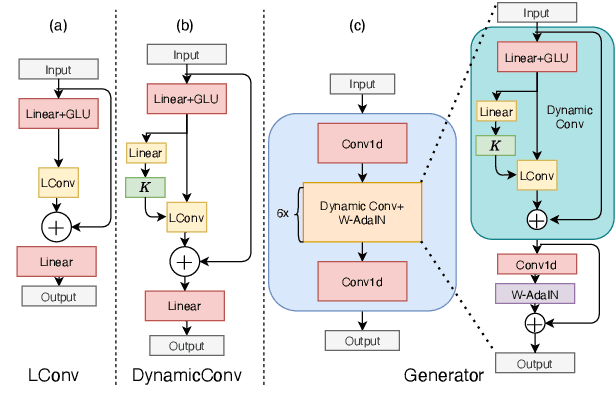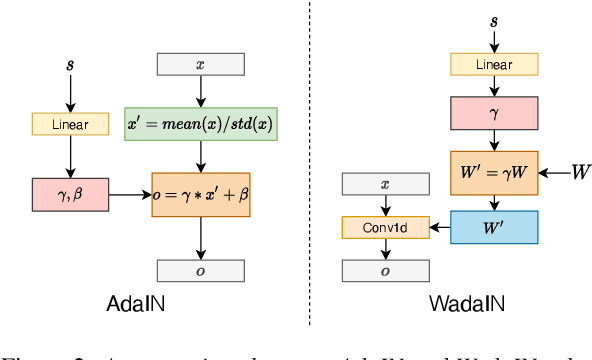Yanghao Zhou
CLASP: Cross-modal Salient Anchor-based Semantic Propagation for Weakly-supervised Dense Audio-Visual Event Localization
Aug 06, 2025Abstract:The Dense Audio-Visual Event Localization (DAVEL) task aims to temporally localize events in untrimmed videos that occur simultaneously in both the audio and visual modalities. This paper explores DAVEL under a new and more challenging weakly-supervised setting (W-DAVEL task), where only video-level event labels are provided and the temporal boundaries of each event are unknown. We address W-DAVEL by exploiting \textit{cross-modal salient anchors}, which are defined as reliable timestamps that are well predicted under weak supervision and exhibit highly consistent event semantics across audio and visual modalities. Specifically, we propose a \textit{Mutual Event Agreement Evaluation} module, which generates an agreement score by measuring the discrepancy between the predicted audio and visual event classes. Then, the agreement score is utilized in a \textit{Cross-modal Salient Anchor Identification} module, which identifies the audio and visual anchor features through global-video and local temporal window identification mechanisms. The anchor features after multimodal integration are fed into an \textit{Anchor-based Temporal Propagation} module to enhance event semantic encoding in the original temporal audio and visual features, facilitating better temporal localization under weak supervision. We establish benchmarks for W-DAVEL on both the UnAV-100 and ActivityNet1.3 datasets. Extensive experiments demonstrate that our method achieves state-of-the-art performance.
AdaKWS: Towards Robust Keyword Spotting with Test-Time Adaptation
May 20, 2025Abstract:Spoken keyword spotting (KWS) aims to identify keywords in audio for wide applications, especially on edge devices. Current small-footprint KWS systems focus on efficient model designs. However, their inference performance can decline in unseen environments or noisy backgrounds. Test-time adaptation (TTA) helps models adapt to test samples without needing the original training data. In this study, we present AdaKWS, the first TTA method for robust KWS to the best of our knowledge. Specifically, 1) We initially optimize the model's confidence by selecting reliable samples based on prediction entropy minimization and adjusting the normalization statistics in each batch. 2) We introduce pseudo-keyword consistency (PKC) to identify critical, reliable features without overfitting to noise. Our experiments show that AdaKWS outperforms other methods across various conditions, including Gaussian noise and real-scenario noises. The code will be released in due course.
Efficient Non-Autoregressive GAN Voice Conversion using VQWav2vec Features and Dynamic Convolution
Mar 31, 2022



Abstract:It was shown recently that a combination of ASR and TTS models yield highly competitive performance on standard voice conversion tasks such as the Voice Conversion Challenge 2020 (VCC2020). To obtain good performance both models require pretraining on large amounts of data, thereby obtaining large models that are potentially inefficient in use. In this work we present a model that is significantly smaller and thereby faster in processing while obtaining equivalent performance. To achieve this the proposed model, Dynamic-GAN-VC (DYGAN-VC), uses a non-autoregressive structure and makes use of vector quantised embeddings obtained from a VQWav2vec model. Furthermore dynamic convolution is introduced to improve speech content modeling while requiring a small number of parameters. Objective and subjective evaluation was performed using the VCC2020 task, yielding MOS scores of up to 3.86, and character error rates as low as 4.3\%. This was achieved with approximately half the number of model parameters, and up to 8 times faster decoding speed.
Temporal Network Representation Learning via Historical Neighborhoods Aggregation
Mar 30, 2020



Abstract:Network embedding is an effective method to learn low-dimensional representations of nodes, which can be applied to various real-life applications such as visualization, node classification, and link prediction. Although significant progress has been made on this problem in recent years, several important challenges remain, such as how to properly capture temporal information in evolving networks. In practice, most networks are continually evolving. Some networks only add new edges or nodes such as authorship networks, while others support removal of nodes or edges such as internet data routing. If patterns exist in the changes of the network structure, we can better understand the relationships between nodes and the evolution of the network, which can be further leveraged to learn node representations with more meaningful information. In this paper, we propose the Embedding via Historical Neighborhoods Aggregation (EHNA) algorithm. More specifically, we first propose a temporal random walk that can identify relevant nodes in historical neighborhoods which have impact on edge formations. Then we apply a deep learning model which uses a custom attention mechanism to induce node embeddings that directly capture temporal information in the underlying feature representation. We perform extensive experiments on a range of real-world datasets, and the results demonstrate the effectiveness of our new approach in the network reconstruction task and the link prediction task.
 Add to Chrome
Add to Chrome Add to Firefox
Add to Firefox Add to Edge
Add to Edge